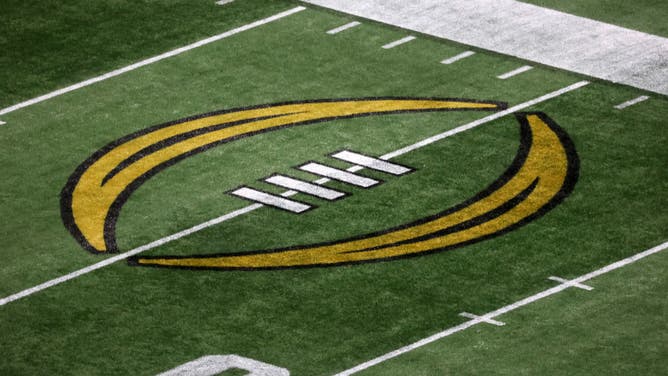SEC, Big Ten Using Their Authority To Dictate Future Of College Football Playoff, Money Still Rules CFB
Before we start the anticipated 12-team playoff in college football, a 14-team expansion is going to be the format in 2026.
It's almost comical how quickly this has started to come together over the past year, as the SEC and Big Ten both expanded their boundaries in college athletics. If you were wondering how much power these two conferences have in the negotiations of a new playoff format, other conferences are doing their best to appease the Power-2, while negotiating their own spots in the future.
Spare yourself the thought that any of this has to do with fairness, as it all comes down to the button dollar. But in a world where billion dollar television contracts have become the focal point of future broadcasting rights, none of this should be surprising.
While SEC commissioner Greg Sankey and Big Ten commissioner Tony Petitti are doing what's best for their own conferences, others in the Big 12 and ACC are just trying to get a bigger piece of the pie.
One of these ongoing deliberations has to do with how many automatic qualifiers each conference will get in 14-team playoff. While the Big Ten and SEC have the power in numbers, both still need to appease opposing conferences, and Group of Five members.
It was just last week that College Football Playoff executive director Bill Hancock mentioned that a new format would need to be voted on within a month, meaning mid-march is the soft deadline that committee members need to finalize a plan.
As pointed out last week, the presence of a television deal with ESPN for $1.3 billion per year is a driving force in getting the playoff format finalized. Heading into meetings last week in Dallas, committee members were discussing a playoff that would see the Big Ten and SEC receive four automatic qualifiers in the CFP.
Seven Day Give: New Format Of CFP Automatic Bids Discussed This Week
But, just a week later in Indianapolis, the play for four automatic qualifiers had shifted to three, because of the mega-powers conceding that this would be the most likely way that the SEC and Big Ten get what they want, including the financial side. There are other models being thrown around by committee members, but it seems as if most members can already tell where this is headed.
When you look at what Tony Petitti is putting in-front of the committee, it's hard to argue with the Big Ten wanting the heavy side of automatic qualifiers. By adding Washington, Oregon, USC and UCLA, the conference is stacked. Last year the Huskies and Michigan made the four-team playoff.
As for the SEC, there is not much Greg Sankey can say that hasn't been seen over the past 15 years. Whether it's Georgia, Alabama or LSU, the SEC hasn't had to sweat out a potential absence, even if Alabama was voted in last season over Florida State. Either way, the SEC has been represented, and the money Greg Sankey's conference is getting from ESPN in its new television deal is set to begin this season, It is further proof that the SEC has the CFP in the palm of their hand, along with the Big Ten.

ATLANTA, GA - DECEMBER 31: A general view of the CFP logo before the college football Playoff Semifinal game at the Chick-fil-a Peach Bowl between the Georgia Bulldogs and the Ohio State Buckeyes on December 31, 2022 at Mercedes-Benz Stadium in Atlanta, Georgia. (Photo by Michael Wade/Icon Sportswire via Getty Images)
"We're just trying to stay in the conversation and get the money we feel we deserve. I would say we should all work together for the future of college athletics, but that ship has sailed," one Group of Five AD told OutKick. "It's understood that the SEC and Big Ten are sitting at both heads of the table, but that doesn't mean we have to agree on every point they try to get passed. It's all about finances, which should be obvious by how many automatic bids each of them are looking for. Give them six now, who knows what it would look like once the new deal is coming to an end.
"We know our place in college athletics, but we also know that if we're going to survive in the long term, we have to get our money now. Who knows that those two (Big Ten, SEC) will end up doing over the next five to 10 years. Hell, they could have their own super-league and leave us behind to eat the scraps. So yes, we're going to give into some of their requests, but they aren't the only game in town."
One of the biggest questions that is being argued right now in these meetings center around how many automatic qualifiers other conferences will get. According to sources familiar with the ongoing conversations, the ACC and Big 12 would receive two automatic qualifying bids per season, while one spot would go to a Group of Five team.
The final three spots in the playoff would go to at-large teams, which could also include teams from the SEC or Big Ten. If there was an SEC team that did not get one of the automatic bids, but was ranked 14th in the final rankings, there is a good chance that spot would be taken by the conference.
Don't forget Notre Dame in this whole equation, who would get a small percentage of the CFP revenue, and a spot in the playoffs, if the Fighting Irish were to be ranked inside the top-14 in the final rankings.
We would then get the same type of reaction that followed the Florida State debacle of the 2023 season, that say the Seminoles sitting at home. Now, even though most of that hinged on the fact the Jordan Travis was not available, this type of argument could present itself in the new model, minus the injury factor.
Money Runs The World, And The College Football Playoff
Obviously the SEC and Big Ten feel as though they've done enough over the previous decade to prove to the committee and other conferences that the scales should be favored in their direction when it comes to payouts.
According to Heather Dinich, the leading thought process right now inside the room is that the SEC and Big Ten would receive anywhere between 25% and 30% of the college football playoff revenue. This would be make sense if the conferences were to receive a combined six automatic bids.
The new-look Big 12 would receive anywhere between 15% and 20%, but there is another problem that could be solved in the next year or so. The ACC would be set to split that percentage with the Big 12 conference, but the unknown of Florida State's future in the conference has made this part a talking point. What if the Seminoles were to leave the ACC before the new format was to begin? Then, who would follow Florida State out of the ACC if this were to happen?

These are the type of questions that have ACC officials worried about their monetary situation over the next few years. The easy solution is that the conference agrees to split the 15%-20% and then have Florida State fend for itself, wherever they ended up. If the Seminoles were to leave, it would certainly be interesting to see how its new conference would try to drain a few more percentage points from the committee, but that would have to come after the new deal expires.
No matter how this plays out, prepare for the news to come in the next month or so. If it doesn't, that means the ACC, Big 12 and Group of Five schools are putting up a bigger fight than once thought.
I'd lean toward the money winning at the end, which is how we got to this point in the first place.